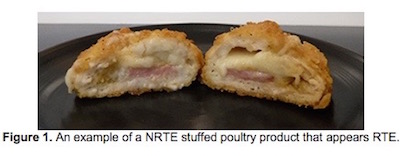The USDA’s Food Safety and Inspection Service (FSIS) is updating inspection instructions for establishments that produce raw and heat-treated but not fully cooked, not shelf stable stuffed chicken products. These products have been linked to Salmonella outbreaks that caused the eighth largest food poisoning outbreak of 2015. The stuffed chicken products were made by Aspen Foods and Barber Foods.

Personnel are to update the profiles so FSIS can determine which establishments product not ready to eat (NRTE) stuffed chicken products that look ready to eat. FSIS will use this information to schedule a public health risk evaluation to make sure the Hazard Analysis and Critical Control Point (HACCP) plans have been reassessed in response to those outbreaks. A food safety assessment may need to be conducted after that evaluation.
Manufacturers of these products have improved their labeling to make sure that the consumer knows the product is raw, and that the products should not be microwaved because this may mean the product will be undercooked. Industry has also taken steps to validate the cooking instructions to make sure that when cooked according to instructions, the product will be safe to consume. In the Barber Foods and Aspen Foods outbreaks, some consumers who were sickened told investigators that they had cooked the product according to label directions and tested the final temperature with a food thermometer.
From 1998 to 2015, there have been nine outbreaks linked to NRTE stuffed chicken products that look like they are ready to eat. These products contain raw, comminuted chicken breast meat or whole chicken breast raw, but the finished product is heat-treated to set the batter or breading. The products are par-fried in hot oil. They look cooked and ready to eat, but are not cooked and are not ready to eat. There are ready to eat versions of these products on the market. This instruction does not apply to those products.
This process is considered “high priority” and personnel must complete it no later than 30 days following the assessment of the task.
The Salmonella outbreaks linked to Aspen Foods and Barber Foods raw, stuffed, frozen, not ready to eat chicken products ended last year, but consumers may still have some of those products in their home freezers. Read the recall notices carefully and check your freezer.
If you have these products, do not eat them even if you cook them to a safe internal temperature as measured with a food thermometer. The product may be so contaminated that even the breading, which can fall off as the product is opened and placed on a cookie sheet, can cross-contaminate utensils, work surfaces, and other foods. And if the product is that contaminated, the Salmonella bacteria in it can produce toxins that can make you sick and are not destroyed with heat.
If you ate any of the recalled products and experienced the symptoms of Salmonella food poisoning, which include nausea, vomiting, abdominal pain, diarrhea that may be bloody, fever, chills, headache, and muscle pains, see your doctor. Salmonella infections can have serious long-term complications, including reactive arthritis, high blood pressure, and irritable bowel syndrome.




